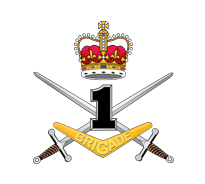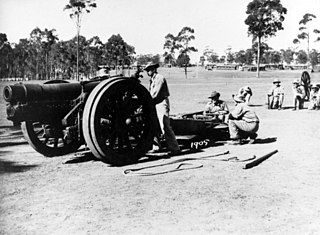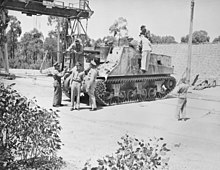
The 3rd Division was an infantry division of the Australian Army. Existing during various periods between 1916 and 1991, it is considered the "longest serving Australian Army division". It was first formed during World War I, as an infantry division of the Australian Imperial Force and saw service on the Western Front in France and Belgium. During this time it fought major battles at Messines, Broodseinde Ridge, Passchendaele, Amiens, and the St Quentin Canal.

1st Brigade is a combined arms formation of the Australian Army. Formed in 1903 as a militia formation based in New South Wales, it was reconstituted as part of the Australian Imperial Force in 1914 for service during World War I, the brigade fought at Gallipoli and on the Western Front before being disbanded in mid-1919. In 1921, the 1st Brigade was re-raised as a unit of Australia's part-time military forces, based in New South Wales. During World War II the brigade undertook defensive duties before being disbanded. In 1948, it was re-raised as an integral part of the Australian Regular Army. Currently the brigade is based at Robertson Barracks in Darwin and at RAAF Base Edinburgh near Adelaide, South Australia. It is the first of the Australian Army brigades to be re-organised as a combat brigade under Plan Beersheba.

The 3rd Armoured Division was an armoured unit of the Australian Army during World War II. Originally raised in 1921 as the 1st Cavalry Division, the formation had been converted into a motor division in early 1942, before adopting the armoured designation in November 1942. A Militia formation, the division undertook garrison duties in New South Wales and then Queensland and did not see combat before being disbanded in late 1943 and early 1944.

The 3rd Brigade is a combined arms brigade of the Australian Army, principally made up of the 1st and 3rd Battalions of the Royal Australian Regiment. Initially raised in 1903 as part of the post-Federation Australian Army, it was removed from the order of battle in 1906 following the restructure of the field force. It was re-formed in 1914 for service during World War I, taking part in the fighting at Gallipoli and on the Western Front in Europe. During World War II the brigade was used in a defensive role before it was disbanded in 1944. It was re-raised in 1967 for service during the Vietnam War and later went on to provide the nucleus of the deployment to East Timor during the Australian-led intervention in 1999. The brigade is currently based at Lavarack Barracks in Townsville, Queensland.
The 48th Field Battery, Royal Australian Artillery was an artillery battery of the Australian Army. The battery traced its lineage back to a unit that was formed for service during the First World War. Assigned to the 9th Brigade, it was located at Keswick Barracks in South Australia until mid-2013 when it was amalgamated with the Launceston-based 16th Field Battery, to form the 6th/13th Light Battery.
The Reserve Artillery Brigade was an artillery unit raised as part of the First Australian Imperial Force during World War I. Formed in Egypt in January 1916 as the Artillery Training Depot. Designated as the Artillery Training Depot, the formation arrived in England on 20 June 1916. The brigade was officially renamed the Reserve Artillery Brigade on 28 November 1916. It was made up of five field batteries and provided trained reinforcements to units deployed on the Western Front.
The 4th Regiment, Royal Australian Artillery is an artillery unit of the Australian Army. Currently it provides close artillery support to the 3rd Brigade and is based at Chau Pha Lines, Lavarack Barracks in Townsville, Queensland. The regiment was raised in its current form in 1960 and is currently re-equipping with M777A2 lightweight towed howitzers. The regiment deployed during Australia's commitment to the Vietnam War and has subsequently deployed to Singapore and East Timor.
The 2nd/10th Field Regiment, Royal Australian Artillery was an Australian Army Reserve artillery regiment, assigned to the 2nd Division. Formed in 1991, and based in Victoria, the regiment drew on the lineage of a number of disbanded units that had previously existed in that state. In 2013, the regiment was reduced to a single battery, designated the 2nd/10th Light Battery. It was assigned to the 5th/6th Battalion, Royal Victoria Regiment, and tasked with training artillery observers and organic fire support to the battalion. It was equipped with the L16 81mm Mortar as the primary armament, while M2A2 Howitzers were retained for ceremonial purposes.
The 8th/12th Regiment, Royal Australian Artillery, was formed at the Holsworthy Barracks on 16 November 1973 through the amalgamation of the 8th Medium Regiment (RAA) and the 12th Field Regiment (RAA). The Regiment provides field artillery support to the 1st Brigade based in Darwin. It is currently equipped with 155mm M777 Howitzers.

The 2nd Armoured Brigade was a formation of the Australian Army during World War II. The brigade was formed in July 1941, at Puckapunyal, Victoria, from Second Australian Imperial Force volunteers. It was assigned to the 1st Armoured Division in July 1941, with the intention of deploying it to the Middle East. However, it was reassigned to home defence following Japan's entry into the war, and was then transferred to the 3rd Armoured Division in October 1942. The brigade remained in Australia, undertaking defensive duties in Victoria and Queensland before being disbanded in January 1944. While it did not see any active service as a formation, some of its constituent units eventually took part in the campaigns on Tarakan, Labuan, Bougainville and around Aitape–Wewak in 1944–1945 after transferring to other brigades.

The 10th Brigade was an infantry brigade of the Australian Army. Originally formed in 1912 as a Militia formation, the brigade was re-raised in 1916 as part of the expansion of the Australian Imperial Force following the end of the Gallipoli campaign. It subsequently saw service on the Western Front in France and Belgium during the First World War. After the war it was disbanded but was re-raised in 1921 as a part-time formation based in the state of Victoria. During the Second World War the brigade was used in a garrison role in Australia before being disbanded in 1942.

The 4th Light Horse Regiment was a mounted infantry regiment of the Australian Army during the First World War. The regiment was raised in August 1914, as the divisional cavalry regiment for the 1st Division. The regiment fought against the forces of the German Empire and the Ottoman Empire, in Egypt, at Gallipoli, on the Western front, on the Sinai Peninsula, and in Palestine and Jordan. After the armistice the regiment eventually returned to Australia in March 1919. For its role in the war the regiment was awarded twenty-one battle honours.
The 103rd Medium Battery is an artillery battery unit of the Royal Australian Artillery. The battery was formed in 1916, known as the 103rd Field (Howitzer) Battery and served during World War I. Its successors have fought in the Indonesia–Malaysia confrontation and the Vietnam War and the battery is currently part of the 8th/12th Regiment, Royal Australian Artillery, based in Darwin, Northern Territory, as part of the 1st Brigade.

The 13th Field Regiment was an Australian Army artillery regiment. During World War I the unit was formed in early 1916 as the 13th Field Artillery Brigade, and fought as part of the 5th Division in Egypt, the Sinai and on the Western Front. After the war, it was re-raised as a part-time unit based in the state of South Australia. It was redesignated as the 13th Field Regiment during the early years of World War II, and following Japan's entry into the war it was mobilised and later deployed to New Guinea where a detachment fought during the Battle of Buna–Gona in 1942–1943, returning to Australia in late 1943. After the war, the regiment was re-formed in 1948 in South Australia and remained in existence until being disbanded in 1975.
H Battery Royal Horse Artillery is a battery of 1st Regiment Royal Horse Artillery, part of the Royal Horse Artillery of the British Army. As of 2015, it is based at Albemarle Barracks, Northumberland, England and is equipped with GMLRS.
The 9th Regiment, Royal Australian Artillery is an artillery regiment of the Australian Army. It draws lineage from an artillery unit raised in 1903, which provided personnel to artillery units raised for service during World War I seeing action on the Western Front. It was mobilised for service during World War II and undertook defensive duties in Australia before being disbanded in 1944. The regiment was re-raised as part of the Australian Army Reserve in 2018, and currently provides artillery support to the 2nd Division. It consists of six light batteries, which are based at numerous depots around the country. The regiment's headquarters is based in Sydney, New South Wales.

The 2/1st Medium Regiment was an artillery regiment of the Australian Army during World War II. Raised in 1940 as part of the all volunteer Second Australian Imperial Force, the regiment undertook garrison duties in Australia, Nauru and on Ocean Island, and served in the Middle East. It was converted to a field regiment, designated the 2/13th Army Field Regiment, due to a lack of howitzers, but was later converted back into a medium regiment. During 1943–1944, the regiment served as the 2/13th Composite Anti Aircraft Regiment before returning to the medium role. It was disbanded in July 1945, in Queensland.

The 2/3rd Anti-Tank Regiment was an Australian Army anti-tank artillery regiment that was raised for service during the Second World War as part of the all volunteer Second Australian Imperial Force. It was formed in July 1940, and was assigned to the 8th Division, but was later reassigned to the 9th Division. With this formation, the regiment took part in the Siege of Tobruk in 1941 and then the First and Second Battles of El Alamein in 1942. After returning to Australia in early 1943, the regiment became a corps-assigned unit, and its individual batteries served in New Guinea in 1943–1944, and then Borneo against the Japanese in 1945.
The 23rd Regiment, Royal Australian Artillery was an Australian Army artillery regiment of the Australian Army. Raised in 1948 as a Citizen Military Forces anti-tank unit designated the 3rd Anti-Tank Regiment, it was converted to a field artillery regiment in the 1950s. It supported the 5th Brigade until being reduced to a battery-sized sub unit, and assigned to the 9th Regiment, Royal Australian Artillery in 2018.











